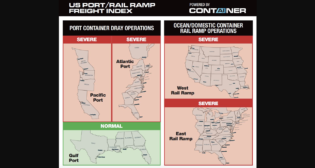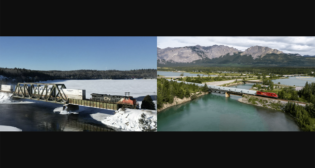
‘Here’s the Data. Have Fun With It’
Written by William C. Vantuono, Editor-in-Chief
Feb. 3 marks the one-year “anniversary” of Norfolk Southern’s East Palestine, Ohio, derailment, which quickly turned into a media circus, flavored with tasty fodder appealing to preaching, finger-pointing politicians. We’ve covered the facts and fiction the accident and its aftermath generated. One year later, we’re still covering it, and the Federal Railroad Administration hasn’t been much help.
The most recent story in the wave of media coverage is Peter Eavis’s Jan. 28 New York Times article, “Since Ohio Train Derailment, Accidents Have Gone Up, Not Down.” It’s a well-researched story on railroad safety, and on balance isn’t too sensational, as many of these so-called investigative stories tend to be. For example, the author does point out that “rail is far safer than trucking for transporting hazardous materials.”
However, this article, like many on railroads published in the general media, contains a great deal of inaccuracy and misleading information—but it’s not necessarily the writer’s fault.
“The total number of accidents for the top five freight railroads increased, and Congress still hasn’t passed legislation to prevent similar disasters,” Eavis writes. “After a freight train carrying hazardous chemicals derailed a year ago in East Palestine, Ohio, forcing the evacuation of hundreds of residents and upending life in the town for months, the rail industry pledged to work to become safer, and members of Congress vowed to pass legislation to prevent similar disasters. No bill was passed. And accidents went up.”
The Times story points out that derailments rose at the “five” largest railroads in 2023, “according to regulatory reports for the first 10 months of the year, the most recent period for which data exists for all five companies.” Eavis writes that the accident “forced an examination of how the rail industry is regulated and its safety record.”
That’s true … but what follows clearly resulted from misinterpretation:
“Despite that scrutiny, the five Class I freight railroads operating in the United States—Union Pacific, BNSF, CSX, Norfolk Southern and Canadian National—reported 256 accidents on their main lines last year through October, an 11% increase over the same period in 2022, according to data compiled by the FRA. The five railroads had reported an aggregate decline in accidents in 2021 and 2022. Derailments, the most common accident, were up 13.5% last year, and ‘obstruction accidents,’ a term used to describe a train striking certain objects, and the second most common category, rose 21%. The [FRA] also compiles accident causes, and this data shows that there were 17 incidents involving overheated wheel bearings in the first 10 months of last year—more than double the six recorded in the same period of 2022 and higher than any full year’s total since 2014.”
Pardon me for nitpicking, but there six, not five, Class I freight railroads operating in the U.S. What about Canadian Pacific Kansas City? Kind of tough to overlook, don’t you think?
More important, from where did the information that generated these percentages—which on the surface look rather alarming—come? The FRA, naturally, the compiler of safety statistics. But while FRA may have provided the Times with mountains of data, the agency apparently did little or nothing to help the writer interpret that data, and help ensure a story as accurate as possible. That’s provided, of course, there is no hidden agenda or bias on the part of the newspaper. The Times, generally, tends toward accuracy and fairness.
However …
“I really don’t fault the Times writer,” comments Railway Age Capitol Hill Contributing Editor Frank N. Wilner. “It’s general circulation, and he works with what he is fed. The problem is at the feed lot, in my opinion. Troublingly, the FRA has failed its communications mission in not making clear that the majority of mandatorily reportable rail accidents are the equivalent of fender benders, and that the majority of mandatorily reportable derailments are minor incidents occurring in rail classification yards. This is not the first time—nor will it be the last—that the public is presented with an arguably intentionally biased view of railroad safety. Unlike the independent National Transportation Safety Board and Surface Transportation Board, which are meticulous in attention to facts and detail, Executive Branch agencies such as the FRA too often succumb to a political agenda in their presentation of data.”
Eavis did go to the industry for comment, contacting the Association of American Railroads, NS, CSX, UP and BNSF. “We are absolutely, despite the uptick in some numbers in ’23, still by far the safest way to move goods over land, especially hazmat,” AAR chief executive Ian Jefferies told him. “And we’ve got to work every day to continue to drive those numbers further down.” The AAR consistently strives to be reliable and transparent about data, but the stories that eventually make the news still lean toward the negative—something I’ve been observing for more than 30 years.
Spokespersons at the four Class I’s cited in the article said basically the same thing about rail safety as the AAR, but their comments were preceded by the misleading numbers obtained from the FRA.
I’ve spoken my peace on the Rail Safety Act, which I’ve said many times is a politically motivated, totally unnecessary exercise in wasted time and resources. As expected, the legislation is covered in the Times article:
“In response to the accident, members of Congress in March introduced a bipartisan bill aimed at making railroads safer. But crucial parts of the legislation—including a requirement that railroads use more detectors to identify overheated wheel bearings—have faced resistance from rail lobbyists, who contend that they would inhibit the ability of railroads to introduce new practices and technologies to reduce accidents. The bill has yet to be put up for a full vote in the Senate. ‘These figures show the railroad industry’s safety standards are getting worse,’ said Senator J.D. Vance, Republican of Ohio and a co-sponsor of the bill. ‘We can reverse the trend by passing the Railway Safety Act immediately.’”
Yeah, OK …
If the Federal Railroad Administrator is willing to submit a rebuttal under his byline, I’ll publish it. But I’m not holding my breath.



